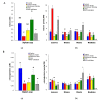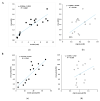Application of Nitrate, Ammonium, or Urea Changes the Concentrations of Ureides, Urea, Amino Acids and Other Metabolites in Xylem Sap and in the Organs of Soybean Plants (Glycine max (L.) Merr.)
- PMID: 33925462
- PMCID: PMC8123890
- DOI: 10.3390/ijms22094573
Application of Nitrate, Ammonium, or Urea Changes the Concentrations of Ureides, Urea, Amino Acids and Other Metabolites in Xylem Sap and in the Organs of Soybean Plants (Glycine max (L.) Merr.)
Abstract
Soybean (Glycine max (L.) Merr.) plants form root nodules and fix atmospheric dinitrogen, while also utilizing the combined nitrogen absorbed from roots. In this study, nodulated soybean plants were supplied with 5 mM N nitrate, ammonium, or urea for 3 days, and the changes in metabolite concentrations in the xylem sap and each organ were analyzed. The ureide concentration in the xylem sap was the highest in the control plants that were supplied with an N-free nutrient solution, but nitrate and asparagine were the principal compounds in the xylem sap with nitrate treatment. The metabolite concentrations in both the xylem sap and each organ were similar between the ammonium and urea treatments. Considerable amounts of urea were present in the xylem sap and all the organs among all the treatments. Positive correlations were observed between the ureides and urea concentrations in the xylem sap as well as in the roots and leaves, although no correlations were observed between the urea and arginine concentrations, suggesting that urea may have originated from ureide degradation in soybean plants, possibly in the roots. This is the first finding of the possibility of ureide degradation to urea in the underground organs of soybean plants.
Keywords: amino acid; ammonia; arginine; nitrate; nodule; soybean; urea; ureide.
Conflict of interest statement
The authors declare that the research was conducted in the absence of any commercial or financial relationships that could be construed as a potential conflict of interest.
Figures



















Similar articles
-
Effects of Nodulation on Metabolite Concentrations in Xylem Sap and in the Organs of Soybean Plants Supplied with Different N Forms.Metabolites. 2023 Feb 21;13(3):319. doi: 10.3390/metabo13030319. Metabolites. 2023. PMID: 36984759 Free PMC article.
-
Transport of nitrogen in the xylem of soybean plants.Plant Physiol. 1979 Sep;64(3):411-6. doi: 10.1104/pp.64.3.411. Plant Physiol. 1979. PMID: 16660977 Free PMC article.
-
Are phloem-derived amino acids the origin of the elevated malate concentration in the xylem sap following mineral N starvation in soybean?Planta. 2018 Aug;248(2):437-449. doi: 10.1007/s00425-018-2914-x. Epub 2018 May 16. Planta. 2018. PMID: 29767334
-
Early signaling, synthesis, transport and metabolism of ureides.J Plant Physiol. 2016 Apr 1;193:97-109. doi: 10.1016/j.jplph.2016.01.013. Epub 2016 Feb 22. J Plant Physiol. 2016. PMID: 26967003 Review.
-
Ureide biosynthesis in legume nodules.Front Biosci. 2004 May 1;9:1374-81. doi: 10.2741/1345. Front Biosci. 2004. PMID: 14977553 Review.
Cited by
-
Effects of Nodulation on Metabolite Concentrations in Xylem Sap and in the Organs of Soybean Plants Supplied with Different N Forms.Metabolites. 2023 Feb 21;13(3):319. doi: 10.3390/metabo13030319. Metabolites. 2023. PMID: 36984759 Free PMC article.
-
Role of Environmental Factors in Legume-Rhizobium Symbiosis: A Review.Biomolecules. 2025 Jan 14;15(1):118. doi: 10.3390/biom15010118. Biomolecules. 2025. PMID: 39858512 Free PMC article. Review.
-
Rhizobium symbiosis improves amino acid and secondary metabolite biosynthesis of tungsten-stressed soybean (Glycine max).Front Plant Sci. 2024 Apr 2;15:1355136. doi: 10.3389/fpls.2024.1355136. eCollection 2024. Front Plant Sci. 2024. PMID: 38628363 Free PMC article.
-
Effects of Varying N, P, K, Mg, and Ca Concentrations on Nitrogen Transport in Xylem Sap of Rice Plants.Plants (Basel). 2025 Apr 8;14(8):1154. doi: 10.3390/plants14081154. Plants (Basel). 2025. PMID: 40284042 Free PMC article.
-
Integrated Proteomics and Metabolomics Analysis of Nitrogen System Regulation on Soybean Plant Nodulation and Nitrogen Fixation.Int J Mol Sci. 2022 Feb 25;23(5):2545. doi: 10.3390/ijms23052545. Int J Mol Sci. 2022. PMID: 35269687 Free PMC article.
References
-
- Gibson A.H., Harper J.E. Nitrate effect on nodulation of soybean by Bradyrhizobium japonicum. Crop Sci. 1985;25:497–501. doi: 10.2135/cropsci1985.0011183X002500030015x. - DOI
-
- Streeter J.G. Inhibition of legume nodule formation and N2 fixation by nitrate. CRC Crit. Rev. Plant Sci. 1988;7:1–23. doi: 10.1080/07352688809382257. - DOI
-
- Imsande J. Inhibition of nodule development in soybean by nitrate or reduced nitrogen. J. Exp. Bot. 1986;37:348–355. doi: 10.1093/jxb/37.3.348. - DOI
-
- Ohyama T., Fujikake H., Yashima H., Tanabata S., Ishikawa S., Sato T. Effect of nitrate on nodulation and nitrogen fixation of soybean. In: El-Shemy H.A., editor. Soybean Physiology and Biochemistry. InTech; Rijeka, Croatia: 2012. pp. 333–363.
-
- Harper J.E. Soybeans: Improvement, Production and Uses. 2nd ed. Agronomy Monograph; Madison, WI, USA: 1987. Nitrogen metabolism; pp. 497–533.
MeSH terms
Substances
LinkOut - more resources
Full Text Sources
Other Literature Sources
Molecular Biology Databases
Miscellaneous

